
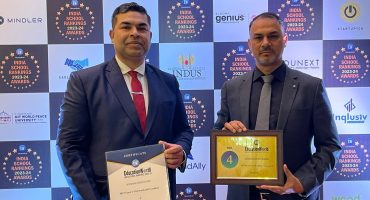



Education World Award Winner
Morning Assembly
Positive Thinking
In a world often filled with challenges, setbacks, and uncertainties, succumbing to negativity is easy. However, I want to remind you that how we think has a remarkable impact on our actions, relationships, and ultimately, our lives.
Positive thinking is not about denying reality or ignoring problems. It’s about approaching life with a constructive mindset, seeking solutions rather than dwelling on difficulties. It’s about finding opportunities in every obstacle and turning setbacks into stepping stones towards success.
Studies have shown that individuals with a positive outlook tend to be more resilient in the face of adversity. They bounce back quicker and are more likely to persevere through difficult times.
Furthermore, positive thinking isn’t just beneficial for our mental well-being; it also has tangible effects on our physical health. But the power of positive thinking extends far beyond individual well-being. It has the potential to create a ripple effect in our communities, workplaces, and beyond. When we approach challenges with optimism, we inspire others to do the same. We foster a culture of collaboration, creativity, and innovation, where people are more willing to take risks and push boundaries.
So, let us remember that each day, we have a choice – to view the world through a lens of hope and possibility, or one of doubt and limitation. Let us choose to harness the power of positive thinking, not just for our own benefit, but for the betterment of our communities and the world at large.
By Mr. Karan Tamhane
Cultivating Inner Peace: A Journey Within
In the recent daily assembly, Upasana (an MYP3 student) and I addressed a topic of immense importance — the inner value of peace. In a world often tumultuous and chaotic, I shared a poignant story to illustrate the essence of inner tranquility. The tale of a king seeking a painting to represent peace unfolded, revealing a surprising choice. Instead of selecting a serene landscape, the king chose a painting portraying a tumultuous scene — a barren mountain, stormy skies, and a cascading waterfall. What lay behind the waterfall was a testament to the deeper meaning of peace: a mother bird nurturing its young in the midst of chaos. The king wisely proclaimed that true peace isn’t the absence of challenges but the ability to remain calm amidst the storm. The core message resonated with a timeless truth — the journey towards a peaceful world begins within each individual. The cultivation of inner peace becomes a beacon, radiating tranquility and compassion to those around us. I have emphasized the importance of mindfulness and being present in each moment as the starting point for this journey. Quoting the renowned poet Rumi, he expressed that our struggles are the very places where the light enters us. Challenges, viewed through the lens of growth and resilience, become catalysts for inner illumination. Embracing vulnerabilities and understanding ourselves, our fears, hopes, and dreams, are crucial steps in attaining inner peace. Spirituality was presented as the art of finding inner calm amid life’s difficulties, troubles, and problems. Real peace is not the absence of challenges but the ability to navigate through them with inner calm.
Cultivating Inner Peace: A Journey Within In conclusion, the call to action is clear — the journey towards a peaceful world commences within the corridors of our own hearts. As students navigate the challenges of academic and personal life, they are encouraged to take moments to breathe, reflect, and cultivate peace within. The hope is that this journey toward inner peace becomes a guiding light in their lives. May the pursuit of inner peace be an ongoing endeavor, contributing not only to personal well-being but also to the creation of a more peaceful and harmonious world.
by Ms. Sadbhavana Singh.
Importance of Respecting Mother Nature
On 10th October 2023, a highly informative session on ‘The Importance of Respecting Mother Nature’ was conducted in the block assembly of 2/1. This session, spearheaded by Nivaan, a proactive student from MYP 1 Chandra, along with the guidance of Ms. Archna, aimed to educate and engage the school community on the critical topic of environmental conservation.
Nivaan, a student of MYP 1 Chandra, delivered a captivating speech emphasizing the intricate relationship between humans and nature. He highlighted the diverse ecosystems, the alarming rate of deforestation, and the impact of pollution on our environment. The speech received a positive response, inspiring students to consider their impact on the environment and take proactive steps for a sustainable future.
Ms. Archna, an experienced educator, provided expert insights into the environmental challenges our planet faces today. She emphasized the urgent need for sustainable living and shared practical tips on how individuals can reduce their carbon footprint. Her expertise added depth to the session, providing the audience with a broader understanding of the issues at hand.
The session concluded with a powerful call to action, urging everyone present to make conscious efforts in their daily lives to respect and preserve Mother Nature. Students were motivated to initiate eco-friendly projects within the school, such as tree-planting drives and waste-reduction campaigns. Ms.Archna emphasized the importance of collective action and encouraged students to spread awareness in their families and neighborhoods.
Respect for language
As an Indian, living in a country with over 121 different languages and 270 different native languages, I have come to appreciate the diversity of different languages. It is no wonder that our diversity is a blessing.
An author once said, “If you speak to a man in a universal language, you are just talking to him. But if you speak to him in his native language, you speak to his heart.” This saying could not be truer, as I recall a time when I was teaching one of my students to improve his grammar, and we were having a discussion about other languages. During our discussion, this student expressed his distaste for another language. In my response, I communicated that I heard his position. However, I disagreed with it, and I gave many reasons as to why I disagreed with his position. When we discussed it further, he realised the distaste is not for the language but for the complexity of syntax and grammar. To respect
a person’s language is to respect their culture, which, if deeply analyzed, means to appreciate its uniqueness, its diversity, and its intrinsic value. Moreover, respect for a language means respecting the beliefs and customs and valuing the important social function. All languages are unique; so, all languages must be respected in the same manner.
Finally, the basic purpose of all languages is to communicate. no language is superior or inferior to another because, at the end of the day, they all serve the same purpose, and that is to foster relationships through communication. So, respect all languages.
By Ms. Priti

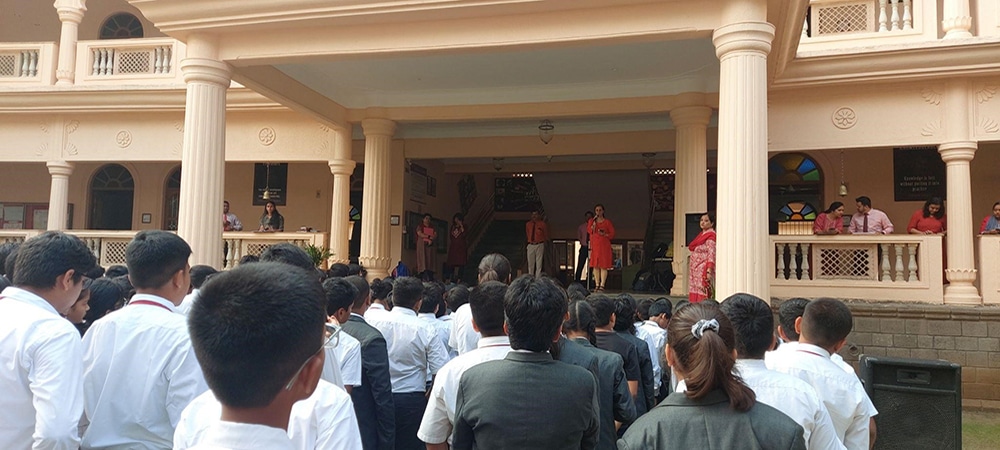






The importance of peace
Each day a teacher addresses a value; which is the value of the month. The value of the month of October was peace and harmony. Today where the world is in turmoil with war and strife, these are values that are very relevant in our troubled times.
On 17th October, Ms Daisy addressed the assembly and spoke about the value of peace and harmony in the world today. She explained how peace is important and as IB students, they must understand the importance of peace and harmony as it is clearly part of the IB mission statement – the IB mission statement clearly reinforces the values of a peaceful world. The IB aims to develop inquiring, knowledgeable, and caring young people who help to create a better and more peaceful world through intercultural understanding and respect.
A small talk was given by Ms Arya Patel and it was followed by a small skit reinforcing the importance of peace – which was put up by the students of MYP 3 class.
The assembly included a thought-provoking skit, co-written by Bhumika G. Singh and Anuj Gandhi. Although this skit faced initial setbacks backstage, thanks to the intervention of the headmaster, it was eventually performed for the entire school community. The skit centered around the life and struggles of Mahatma Gandhi, an iconic symbol of peace, and his role in liberating India from British colonial rule.
Peace and Harmony
 The theme for the 4th week of October 2023 was Peace and Harmony. I got an opportunity to contribute my thoughts on the 21st of October. Bhumika from MYP 3 shared the stage with me with her wonderful speech on the importance of Harmony. We helped students to understand how our thoughts and perspectives can be changed or balanced to create harmony which will maintain peace in the society.
The theme for the 4th week of October 2023 was Peace and Harmony. I got an opportunity to contribute my thoughts on the 21st of October. Bhumika from MYP 3 shared the stage with me with her wonderful speech on the importance of Harmony. We helped students to understand how our thoughts and perspectives can be changed or balanced to create harmony which will maintain peace in the society.
In conclusion, we tried to explain how harmony in society is not an abstract ideal; it is a tangible goal that we must actively work towards. We need to respect and celebrate our differences, promote education and inclusivity, and resolve conflicts peacefully. Only then can we build a world where people of all backgrounds can coexist peacefully, enriching each other’s lives through their diversity. In a harmonious society, we can truly find the unity that brings strength and prosperity to all.
by Ms. Kanchan Pardeshi
Peace through the power of communication to resolve conflict.

I stood before the students assembled in the morning, to discuss a topic that was not only of great significance but also of profound relevance in the world of that time: “Peace through the Power of Communication to Resolve Conflict.” In a world where conflicts and disputes seemed all too common, the skills of communication played a pivotal role in mitigating tensions and fostering harmonious coexistence. I emphasized the role of ATL skills (Approaches to Learning) in achieving this noble goal.
ATL skills were a set of crucial skills that we all possessed and could develop further. I asked students questions related to the topic. The students were very responsive and answered that they enabled them to communicate, think critically, and collaborate effectively. When it came to conflict resolution and peace-building, students said that effective communication lies at the heart of conflict resolution. By expressing ourselves clearly and actively listening to others, we could understand different perspectives and find common ground. Which helps bridge gaps and dispel misunderstandings. When asked how critical thinking play an important role in resolving conflicts, they said that it allowed them to analyze situations objectively, and identify the root causes of conflicts. When we approach conflicts with a critical mindset, we can assess information, evaluate arguments, and make informed decisions.
Peace could seldom be achieved single-handedly. Collaboration skills were essential for working together with diverse groups of people, pooling resources, and finding mutually beneficial solutions. The students advocated that by fostering cooperation and teamwork, we built the foundations of a more harmonious world.
I emphasized that self-awareness, emotional regulation, and resilience were key components of self-management skills. In the heat of conflict, emotions could run high. Learning to manage our own emotions and respond to the emotions of others was crucial for maintaining open and constructive dialogue. Empathy, intercultural competence, and effective negotiation were all examples of social skills that enabled us to relate to others in a respectful and empathetic manner. These skills helped in building trust, finding common ground, and promoting understanding.
In conclusion, I requested the students not to lose sight of the power we hold within ourselves. By honing our ATL skills, we could become effective peacemakers and agents of change. We could build bridges, foster understanding, and resolve disputes through open and empathetic communication. It is important to remember that, together, we could be the change we wanted to see in the world. As we strengthened our ATL skills and applied them to resolve conflicts, we could inch closer to the dream of a more peaceful and harmonious world for all.
By Ms. Janet Thomasraje
Peace through the power of forgiveness for self-transformation.

Good Morning everyone. My name is Arni Sankpal, I am currently in MYP 3.
Today, I am going to talk about Peace through the power of forgiveness for self-transformation. I know, something related to peace again, but this topic can actually benefit us into living a life filled with peace, purpose, and boundless potential.
Everybody has moments in their lives when they dwell upon their past and wish they had been a better version of themselves. When it mattered the most, we regret not speaking up, standing out, or doing things that could’ve made it perfect. I am sure most of us here have encountered this same experience. Well, it’s natural human tendency to do so. But what if I told you the golden key to unlocking inner peace and personal growth is in reality forgiveness, especially self-forgiveness?
First, let’s understand the power of unforgiveness. The weight of regret and self-criticism can be quite suffocating. We usually let all those past mistakes, and remorse just keep adding on until it’s too heavy to move on. Letting them haunt our thoughts and dreams. However, the truth is: that life is fraught with mistakes, disappointments, and challenges. So it’s ridiculous to live in a state of unforgiveness towards ourselves and others.
If we think about it, Self-forgiveness is just as important as forgiving others. When we beat ourselves up for our mistakes, we hold ourselves back from growing and healing.
Self-forgiveness is not about condoning our mistakes. It is about accepting that we are all human and that we all make mistakes. It is about learning from our mistakes and moving on. So here are some tips on how we can cultivate forgiveness in our lives:
1) Acceptance- Acknowledge your mistakes without judgement. Allow yourself to feel your emotions, even the negative ones.
2) Understand the other person’s perspective- This does not mean excusing their behaviour, but simply trying to see things from their point of view. Knowing that everyone makes mistakes and has a chance to hurt others can be comforting.
3) Practice Self-Compassion: Treat yourself with the same kindness and understanding you offer to others.
4) Let go of your need for revenge. When we hold onto grudges, we are essentially punishing ourselves. Revenge does not bring closure or healing. It only creates more suffering.
Forgiveness, especially forgiveness, is a successful tool that can lead to inner peace, self-transformation, and a more peaceful world. It opens up new doors of opportunities to evolve into the best of ourselves. Whichever path you choose, keep in mind that the first step to living a life full of peace, meaning, and limitless possibilities is to forgive yourself. Thank you everyone.
By Arni Sankpal MYP 3
Peace through the power of forgiveness for self-transformation.

My aim was to deeply resonate with the students, so I decided to commence the assembly with a heartfelt poem.
A beacon of serenity, a healing drum.
Let go of anger, let resentment cease,
Embrace the balm of forgiveness, and find inner peace.
In forgiving ourselves, we set our spirits free,
To rise above the storms, to be who we can be.
With every act of grace, we heal and mend,
And in the journey of forgiveness, find our peace ascend.
So let forgiveness be the key to our salvation,
A bridge to inner harmony, a profound transformation.
Embrace this power to heal, to find release,
In forgiveness, we discover a lasting, gentle peace.
I conducted an engaging exercise to promote self-reflection and discuss the topic of forgiveness. I began the session by keeping the topic undisclosed and challenged the students to identify it. They were successful in guessing that we would be discussing the importance of saying sorry.
I proceeded to introduce the concept of apologizing and shared my perspective on its significance. I explained to the students that offering an apology allows individuals to acknowledge their mistakes and display empathy, creating an opportunity for conflict resolution and relationship repair. It’s not just about admitting fault but also about fostering personal growth, setting a positive example, and rebuilding trust. Apologies play a vital role in fostering trust, facilitating emotional healing, and promoting personal development in various contexts. They are powerful tools for improving relationships and resolving conflicts genuinely and sincerely.
I then posed a question to the students: “What if your apology is not accepted? What would you feel, and what is it that you are seeking?” The unanimous answer was forgiveness. To facilitate a deeper understanding of forgiveness, I led a brief meditation session. During this exercise, students were encouraged to visualize the person they wished to forgive. This practice resonated with many of them, with some experiencing profound emotions.
Forgiveness, as I discussed with the students, holds the potential to transform individuals, particularly children. It contributes to their emotional well-being, enhances their conflict resolution skills, nurtures empathy, reduces aggression and stress, fosters resilience, promotes self-reflection and moral development, and plays a significant role in decreasing instances of bullying and peer conflicts.
In conclusion, it is essential for parents and educators to both model and teach the value of forgiveness, as it plays a pivotal role in the social and emotional growth of children. This exercise provided an opportunity for students to grasp the importance of apologizing and the transformative power of forgiveness in their lives.
By Ms. Janet Thomasraje
*****************************************************************************
The value of the month “Peace and Harmony” was summarized yesterday. Students recalled what important aspects they had learned throughout the month. It was briefed on internal and outer peace and how to keep harmony to maintain peace.
It was explained that students could maintain their internal peace through a calm mind by doing meditation, regular exercise, and walking to be healthy and stress-free. Also, through previous daily assemblies, peace through communication and forgiveness – an aspect of peace – was recalled with its importance.
Students got to know that humbleness in nature, non-violence, and cooperative nature could bring peace into their lives and help them make good relationships with others in society. Similarly, world peace was necessary to avoid world wars and conflict.
Prisha Dudi, a student of MYP 3 Guru, highlighted the inner and outer peace with harmony by expressing her thoughts on this.
By Ms. Soni Kumari
Special Assembly MYP 3 Report on MYP 3 Assembly
This report focuses on the MYP-3 assembly, which revolved around the theme of “Peace and Harmony.” The assembly featured various elements, including a dance performance, a thought of the day, and news segments, including international, national, and Gurukul news. While there were some initial challenges, the assembly was a beautifully orchestrated event, including a skit that was eventually performed. The MYP-3 assembly was a stunning tribute to the theme of peace and harmony. It commenced with a speech by the teachers, setting the stage for an enlightening experience. The assembly continued with the news segments, meticulously prepared by Prisha D., Venu D., and Anand K. These segments encompassed international news, national news, and Gurukul news, showcasing the dedication and hard work put into their preparation. We were treated to a thought of the day, a Sanskrit shloka presented by Anmol. The assembly reached its zenith with a mesmerizing dance performance by Aashita P. and Prisha D., who gracefully moved to the rhythm of songs like “Dreamers” and “Love You Zindagi.” The event concluded with an award ceremony, and speeches from the coordinators, home room teacher, and the headmaster, which added a splendid touch to the assembly’s grand finale. In conclusion, the MYP-3 students demonstrated exceptional dedication and teamwork in preparing their assembly. Their heartfelt efforts shone through in every aspect of the event, from the skit’s meaningful portrayal of Mahatma Gandhi’s life to the spirited dance performance. The assembly was a testament to all the students’ commitment to the theme of peace and harmony. They certainly deserve a resounding round of applause for their remarkable performance.
By Aashita Pranjal MYP 3
Assembly
The assembly was wonderful. First, they started with the beautiful ‘World Peace Prayer’ and everyone got up and joined their hands. Many people even sang along to the prayer. The assembly was hosted by MYP 3, who did a great job of picturing the value of the month. People from MYP 3 came to the mike and explained about peace and harmony in a spectacular way. One person wrote a poem about peace and harmony and many others read quotes. It was very informative, and once they were done with speaking, they gave us breathtaking performances. They performed songs and danced, their dances were mesmerizing. They even sang, they sang ‘Soldier, King, Poet’ which was an exceptional performance with a beautiful song. The singers sang in a soft and melodic voice. The assembly concluded by distributing awards to the previously held MYP 4 assembly. They even awarded boys for their recent swimming competition. Then, we were given some words and announcements from Ms. Zoha and Mr. Mandar. I loved this assembly for the genuine excitement and happiness while they were performing. It was heartwarming to see these genuine emotions while witnessing a mesmerising performance. Overall, I applaud and am truly grateful for MYP 3 to be taking the time to make this great assembly for us all. This was an amazing way to start the new week.
By Adriana Upadhyay
Service as Action MYP1
Students of MYP1 have recently embarked on an exciting journey within their Language and literature subject. As a part of a unit-related Service as Action (SAA) activity, these young artists, poured their imagination into crafting book covers. Each cover reflected their interpretation of the themes, characters, and emotions that resided within the pages of these fantasy-fiction books. Their book covers represented their understanding of the literary works.







In the spirit of community and knowledge sharing, the students also crafted teaching aids in the form of posters on collective nouns for their young peers in PYP. These colorful and informative posters were not only visually engaging but also served as valuable education tools for our PYPians.
By Ms. Alfiya Shaikh
Service as Action MYP2
The Service as Action program in the International Baccalaureate Middle Years Programme (IB MYP) aims to instill a sense of responsibility, compassion, and global citizenship in students. This year, the Grade 7 cohort embarked on a creative and altruistic venture, demonstrating their commitment to community service by designing and crafting learning puzzles for younger children. This initiative not only exemplifies the spirit of service but also highlights the students’ dedication to education and the well-being of their peers.
The primary objective of this Service as Action project was to create engaging and educational tools that would facilitate the learning process for younger children. By developing puzzles tailored to the cognitive abilities and interests of the target audience, the Grade 7 students sought to foster a love for learning while also enhancing their problem-solving skills.
To kickstart the project, the Grade 7 students engaged in brainstorming sessions, where they discussed various educational themes and concepts suitable for younger learners. These brainstorming sessions were complemented by collaborative efforts with educators, who provided valuable insights into age-appropriate learning objectives.
Once the themes were chosen, the students embarked on the design phase, where they conceptualized and sketched the layout of their puzzles. The students moved on to the production stage, where they brought their designs to life. This involved a combination of craftsmanship, attention to detail, and dedication to quality. The final products were not only a testament to the students’ creativity but also their commitment to producing meaningful educational tools.
The Grade 7 Service as Action initiative exemplifies the transformative potential of education in action. Through their dedication, creativity, and collaboration, these students not only created educational tools but also nurtured a sense of community and responsibility. This project stands as a testament to the power of service in the IB MYP curriculum, inspiring a new generation of compassionate, engaged, and globally-minded individuals.
By Mr. Karan Tamhane
Exploring the Skeletal System: A Hands-on Learning Experience in the MYP 1 Biology Lab
In the MYP 1 Biology lab activity focused on the skeletal system, students actively engaged with skeletal models, identifying various bones and understanding their roles in the human body. Through hands-on exploration, they assembled and disassembled skeletal models, gaining insights into bone articulation and movement. Synthetic bone samples were utilized to demonstrate bone growth and repair processes, emphasizing the body’s ability to regenerate and maintain skeletal integrity. Through these practical exercises, students not only deepened their understanding of bone structure and function but also appreciated the significance of a healthy skeletal system for overall health and mobility.

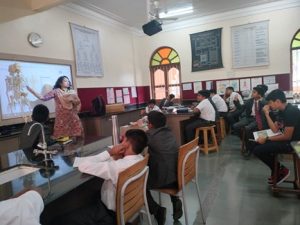

Chemistry Corner
Unit 2 began with a lot of ATL skills and lab activities. The MYP 1 put on their thinking caps in a collaborative activity of designing a birdhouse or pet home with as many materials as they can. They came up with a turtle shelter too. They had a mock radio interview on the recycling of materials and the importance of it.




The MYP 2 made a poem on the Reactivity series of metals. They understood the periodic table and made element cards. They performed lab work on reactivity series. They designed a model of their own mobile phone and discussed the elements used in it and the reason.

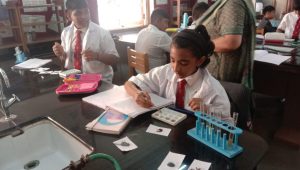
The MYP 3 studied the reaction race through particle theory and kinetics lab work. They had a class discussion on the importance of time in all aspects of life and touched upon their self-management skills. The catalysts used in daily life were discussed.
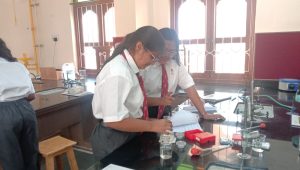


The MYP 4 and DP 1 are both studying Chemical bonding. They made three-dimensional models of covalently bonded compounds using moly mods and balloons and learned the Bonding through cartoons and posters. The DP 1 students used TOK in Chemistry to understand the evolution of using glass since ancient times.
By Ms. Alka Chaturvedi
Peek at our chemistry class
As we know in the 19’s period there used to be radios now these channels played on the radios are said by a host this host has to have a good voice modulation because instead of seeing the match for example the only way is to know what’s happening is to hear and sometimes these hosts don’t have good modulation.
Now talking about that our class decided to do a radio jockey we made groups and had a interviewer and two interviewees talking on recycling materials.This correlated with our topic which was materials we decided to interview
goldminers,lumberjacks the list was endless.It was interesting to see people’s voice modulation change as they talk about different topics and add their inputs and was really fun to talk about it.
It was really interesting knowing their understanding in the form of a radio jockey. The groups came up with creative scripts which the audience really liked. As radio jockey we have done many other activities but this one was fun because we were learning while having fun, as the groups interacted with the audience with their own voice modulation and their own creative scripts it really helped in understanding the topic “ recycling Material”.
by Antara MYP 1
Unlocking the Secrets of Nutrition: A Journey through Food Tests in Biology
MYP 4 students conducted experiments on food tests to gain practical insights into understanding the nutrient content of both familiar and unfamiliar food samples. Working in small groups of five, they showcased their collaborative and teamwork skills. Their approach to the task was marked by integrity and a commitment to ethical guidelines, emphasizing their principled nature and ensuring a respectful and ethical scientific process. Demonstrating their analytical abilities, they engaged in rigorous data analysis to draw insightful conclusions about the nutritional composition of various food items. Acting as effective communicators, they not only expressed their ideas and queries but also actively listened to their peers, fostering a conducive learning atmosphere. Within these teams, students appreciated diverse perspectives and skillfully utilized each member’s strengths, highlighting their cohesive collaboration. This experience not only enhanced their understanding of biology but also emphasized the significance of integrity, critical thinking, effective communication, teamwork, and responsible laboratory practices in the realm of scientific exploration.



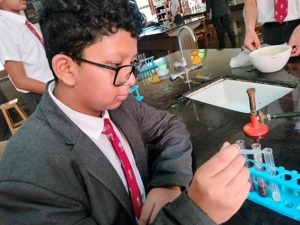
2nd October- A visit to an orphanage.
On the 2nd of October 2023, the young hearts of Hadapsar, Pune, embarked on a heartwarming journey to Anath Arsham, an orphanage and old age home, as a part of their school’s community outreach program. The visit was not only a day of exploration but also a day of deep emotional connection.
The children, accompanied by their teachers, interacted with both the elderly residents and the young orphans. Through conversations and shared stories, the school children witnessed the challenges and joys of the residents, gaining a profound understanding of the lives they lead. It was a moving experience that left an indelible impact on the young minds.
In addition to their interactions, the children actively participated in the Swach Bharat Abhiyan by helping clean and organize the premises of Anath Arsham. This not only made the surroundings more pleasant but also taught them the values of cleanliness and social responsibility.
The visit to Anath Arsham was more than just a school outing; it was a lesson in compassion, empathy, and the importance of giving back to society. The memories created during this visit will undoubtedly stay with these children for a lifetime, reminding them of the power of kindness and the significance of community service.


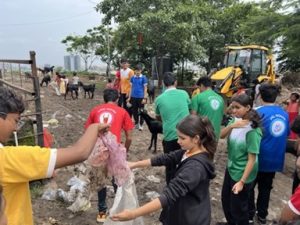
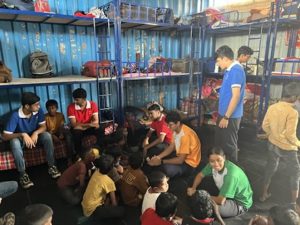
House competition- Garba
Vishwashanti Gurukul World School celebrated the auspicious occasion of Navratri by organizing the annual inter-house garba event on our very own school campus on the 1×1 ground. Garba is a traditional Indian folk dance performed during the Hindu festival of Navratri. It is a joyous dance that celebrates the feminine divine and the victory of good over evil. The Garba event at the school was a celebration of diversity and culture. Students from all backgrounds came together to learn about and enjoy the traditional dance form. The 4 houses participating were the Jal house, which translates to water, Agni house, which translates to fire, Vayu house, which translates to air and the Prithvi house, which translates to the Earth. Each house had been practicing tirelessly for weeks, and the anticipation was palpable. The students were eager to showcase their skills and creativity and to compete in the inter-house event.
The competition began with a brief introduction by our judges, who spoke about the importance of cultural preservation and the significance of Garba as a traditional Indian dance form. The judges then took their seats and called upon the house captains who had picked chits which determined at which number the house would perform the garba. Each house was given a corner where all house members had to be seated and cheer for their house. The first house to perform was Jal. The students were dressed in traditional attire, and they danced with grace and precision. Their performance was a beautiful fusion of traditional and modern Garba moves. The second house to perform was Prithvi. The students had chosen a more upbeat and energetic theme for their performance. They danced with infectious enthusiasm. The third house to perform was Vayu. The students had chosen a more fiery and passionate theme for their performance. They danced with incredible energy and skill, and they brought the house down with their performance. The final house to perform was Agni. The students had chosen a more fiery and passionate theme for their performance. They danced with incredible energy and skill, and they brought the house down with their performance. The students had choreographed their performance around a traditional Gujarati folk song. Their performance was both graceful and playful, and they captivated the audience. Once all four houses had performed, the judges took some time to announce the winners. As the event approached its end, before announcing the winners, 2 dancers from our school – Ms. Nidhi Gandhi and Ms. Mahi Mundada performed garba which was a treat to watch!
Finally, the moment everyone had been waiting for arrived. Before announcing the result, the judges had given their feedback on the dance. The judges announced that the winners of the Interhouse Garba competition were the Jal house! The students erupted in cheers and our 1×1 Ground was filled with a joyous atmosphere. While Jal House emerged victorious, it was evident that the true winners were the students themselves. The Interhouse Garba competition was a resounding success. It was a celebration of Indian culture and children from different cultural backgrounds were exposed to different cultures. We are proud of our school’s initiative to celebrate Navratri in such a meaningful way. We learned a lot about our rich culture and heritage. We also felt a sense of community and solidarity among our school family. We thank the Goddess for her blessings and guidance. We hope to continue this tradition every year. Happy Dussehra!
By Taran Parikh DP1
Garba
Excitement fled the school because of the garba event. I was also thrilled to see all the other performances of all the different houses. When it comes to competitions, gurukul takes it very seriously. It was a house wise competition so the house and sport captains of the houses helped their members with garba. I participated in garba but I had to leave as there was too little time for me to learn the steps. However, I saw my house dance together and it was a great moment for me. Their dancing was spectacular. Garba is mostly celebrated by Indians during festivals, however it was heartwarming when I saw many foreigners signing up for garba. Garba is simply a great time to dance and just have fun. The fact that gurukul presents us with a garba celebration is wonderful. It makes everyone happy. It is always good to celebrate holidays with your friends and family. I find my culture and tradition extraordinary and I am proud of it. We got to show up to school in traditional wear and it was exceptional to see everyone all dressed up and the entire school looking colourful. All of the dances were mesmerising and I loved them. It doesn’t matter who won and who lost, all it matters is that you had fun, and I had a lot of fun. After the brilliant performances, everyone was allowed to do garba. We all got up from our seats and did garba with our friends. It was amazing. I loved this event.
By Adriana Upadhyay
मुझे यह बताते हुए आनंद हो रहा है कि, विद्यालय में हाल ही में आयोजित इंटर-हाउस प्रतियोगिता में सभी हाउस के प्रतिभागियों ने अत्यंत उत्साह से भाग लिया। उनका उत्साह तथा बेहद अच्छे समन्वय ने हमारे विश्वशांति गुरुकुल परिवार की विशेष आकर्षण से भरी भावना को दर्शाया।गरबा प्रतियोगिता ने सभी हाउस के उत्साह भरे ढंग से दर्शकों और निर्णायकगण को प्रभावित किया, उनके प्रदर्शन ने हमारी संस्कृति की समृद्ध विरासत को संजीवनी दी। प्रत्येक नृत्यकर्ता, परंपरागत पोशाक में सजीव, एकता की अद्वितीयता और भारत भूमि की समृद्ध विरासत को व्यक्त करते हुए चलता था।सभी हाउस के प्रतिभागियों की मेहनत,अनुशासन और समर्पण ने उनके अद्वितीय नृत्य में चार चाँद लगाने का कार्य किया|अत: यह इस प्रतियोगिता ने विद्यालय के सभी सदस्यों को मंत्रमुग्ध किया|
By Mr. Vevek Hajaarre


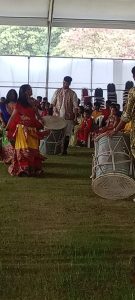

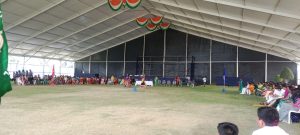


गरबा प्रतियोगिता
२० अक्टूबर २०२३. को हमारे स्कूल में गरबा प्रतियोगिता थी। हमारा विद्यालय हर धर्म के
त्योहारों को मनाने में विश्वास रखता है। गरबा प्रतियोगिता में चार समूह थे (अग्नि, पृथ्वी,
जल और वायु)। उन सभी ने इस प्रतियोगिता के लिए अलग-अलग गानों पर गरबा नृत्य का
अभ्यास किया था। इस प्रतियोगिता के आयोजन का विचार यही था कि छात्रों को अपनी
जड़ों से जोड़े रखें। इस प्रतियोगिता में जल हाउस ने जीत प्राप्त की किंतु हर हाउस को इस
प्रतियोगिता से कुछ-न- कुछ सीखने को अवश्य मिला।
द्वारा- राहुल पुरोहित
कक्षा-दसवीं
Puja and celebration
MIT Vishwashanti Gurukul welcomed parents, teachers, and students to celebrate Saptami by organising a Garba night. Everyone was dressed up in traditional attire complimenting the vibrant decor. We began the event with an auspicious start by praying to goddess Durga. We took turns performing the aarti while the crowd set the rhythm by clapping. Some of us students set up photo booths and game stalls while the school took care of the catering. All funds collected are going to be donated to support girl child education.
Overexcited guests encircled the idols as they danced their hearts out to the beats played by the DJ. Many of us were new to Garba but as soon as we got a hang of it with the help of others, we couldn’t stop ourselves from complimenting the Gujarati remixes with our fresh moves. Despite some twisted and swollen feet, there was full enthusiasm and the surprising element was the on-the-spot coordination amongst us all.
It was a fiesta with devotion, cheers, energy, and excitement. We are looking forward to participating in more celebrations and initiatives and are thankful to the school for allowing us to make this such a memorable night.








IIMUN
Reflection on the I.I.M.U.N Lecture
The students entered the lecture on the I.I.M.U.N. with their typical anticipations of yet another tedious speech, as if they were attending any other academic session. However, the moment the speaker started, it was obvious that this would not be simply another lecture we would have to sit through instead, it would be an informative discussion that would spark our interest and inspire our aspirations.
The manner in which the speaker approached the topic stood out in a remarkable way. She started the presentation by interweaving her personal experiences and tales into the overall structure, rather than delving headfirst into the subject. It was not only about the importance of the I.I.M.U.N but also about how a person’s interests might lead them to become a part of something that has such a significant impact. The little anecdotes she shared from her life connected the environment in which we lived as students and the exciting universe of possibilities that the I.I.M.U.N. had to offer.
The interactiveness of the session enhanced the presentation’s beneficence, which also contributed to the session’s overall success. We shifted from merely acting as recipients of information to active participants in an ongoing conversation by posing questions and expressing our opinions. This strategy was greatly helpful, in particular for those of us who were completely unfamiliar with I.I.M.U.N. It wasn’t simply about an event instead, it was about a life-changing experience that had the potential to shape our futures in the years to come. The story that the orator provided made it understandable for many people, encouraging them not just to learn more about I.I.M.U.N. but also to join it.
After the presentation, the room had a tangible sense of anticipation. In the starting, many of my peers were either unaware of or uninterested in the topic nevertheless, they are now eager to sign up and become a part of it. It was clear that this presentation was successful not only in terms of providing information but also in genuinely motivating people to take some kind of action. The presentation on I.I.M.U.N. was more than just a session dedicated to the presentation of information rather, it was an experience and a source of motivation for all of the students.
By Angel Upadhyay MYP 5



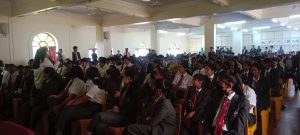
The session on IIMUN had been successful in efficiently informing the students of MITVGS about the components of the event. IIMUN being a prestigious organization harbours students with great potential, allowing them to express themselves. The orator presented a golden opportunity to the students, all while conducting an interactive session. Her personal experience with the organization as a student and an employee has ignited the school spirit. The session ended with multiple students interested in joining the next MUN event held in Pune.
By Aashna Rao DP 1

